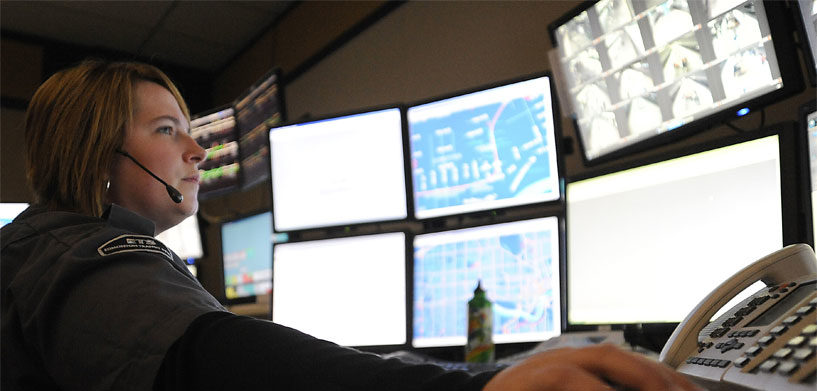The world is changing, and emergency communications centers are changing, too. As technology evolves, next-generation computer-aided dispatch (CAD) tools are opening new lines of communication between the public and comms centers.
In the United States, public safety agencies are gradually working toward implementing Next Generation 9-1-1. Though only available in a handful of states, more than half are actively making the necessary architectural and staff changes necessary for NG9-1-1.
What is NG9-1-1?
From a layman’s perspective, NG9-1-1 will make cities smarter and safer by enabling citizens to report incidents or request help. IP-based systems will allow call-takers to easily communicate with – and also locate – a caller in distress. Most importantly, NG9-1-1 moves the phone backbone of 9-1-1 from old-fashioned legacy technology to an advanced system that dramatically improves both the capability of 9-1-1 and its resilience.
Here are some other benefits:
- Call handling: NG9-1-1 will enable call-takers to view caller location information from multiple calls simultaneously, allowing them to prioritize calls. For example, if there’s a car crash, four or five people might call from that exact location with the same information. Calls about an unrelated emergency at a different location could then take precedence.
- Data management: Modern CAD systems can be integrated with records management systems to help call-takers manage a deluge of data, including recorded messages, texts, chat, photos, and video.
- Sensors: A variety of third-party sensors can immediately inform comms centers about a variety of incidents, from power outages and fires to road flooding. Environmental sensors can detect radiation and biohazards, while on-vehicle sensors can automatically report crashes.
To-do list
There are hundreds of activities that must take place before an agency can implement NG9-1-1. In the earliest phases, they must ensure they have the right design and framework plans, and the proper governance authorities that can work with state leaders and data providers.
Once they’ve established those connections, organizations can focus on planning and developing their NG9-1-1 architecture and establishing Emergency Services IP Networks (ESINets) capable of accommodating all forms of data. This requires replacing outdated wire lines with high-bandwidth connections. The architecture of the new system must also be consistent with National Emergency Number Association (NENA) standards.
NG9-1-1 networks
Implementing an NG9-1-1 network is akin to a technically advanced jigsaw puzzle. In general terms, there is an ingress network (where the call originates), a statewide routing service, and an egress, where a call is routed to a comms center.
An originating ingress network should include:
- Voice over Internet Protocol (VolP) & Telematics: This includes calls not falling under traditional wireline and wireless calls, which should be delivered in accordance with NENA standards. There must also be carrier agreements in place to handle wireline and wireless calls.
Components and considerations for routing services:
- Border Control Functions (BCF): This protects an ESINet from malicious activity.
- Emergency Services Routing Proxy (ESRP): Where a call is processed and delivered to a comms center or regional ESINet.
- GIS services: Because NG9-1-1 relies heavily on GIS data, agencies should make sure protocols are in place to keep GIS databases updated.
- Location Validation Function (LVF): This validates a caller’s address against the GIS database and ensures it’s in the correct form for responders.
- Emergency Call Routing Function (ECRF): This associates a location with a call destination using GIS data.
- Legacy Network Gateway (LNG): An interconnection component between legacy phone networks and the ESINet.
Essential egress components:
- Next-generation hardware & software solutions: Legacy systems within comms centers will require updates, including gateways to convert NG9-1-1 calls back to a legacy format. Industry-leading solutions work seamlessly with NG9-1-1 to deliver richer situational awareness and an innovated user experience (UX) without overwhelming call-takers. Solutions can also be scaled up or down to meet changing needs and extended to the field through a variety of mobile solutions.
- Training: Upgraded or new systems must meet NG9-1-1 specifications and functionality, but they are useless without well-trained personnel in place to operate them. Staff should not only be well-versed in the capabilities of NG9-1-1, but also the tools and interfaces available within CAD systems.
Conclusion
Perhaps the biggest benefit of NG9-1-1 will be the system interoperability that comes with sharing technology and data. Many of the standards connected to NG9-1-1 support interoperability and should offer a financial benefit and better response capabilities to multiple comms centers across a region and/or state. It should also help public safety agencies with contingency planning, as the flexibility offered by NG9-1-1 allows comms centers to work remotely or from other locations in case of an emergency.
Implementing NG9-1-1 might seem daunting, but making the change will improve service quality, provide lower long-term costs, and make cities smarter and safer. Those benefits aren’t just good for this generation, but for many generations to come.
Learn more
To learn more about how an industry-leading, next-generation solution can transform your comms center, check out HxGN OnCall Dispatch.















